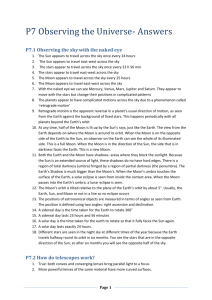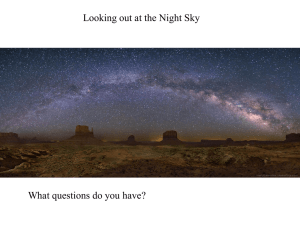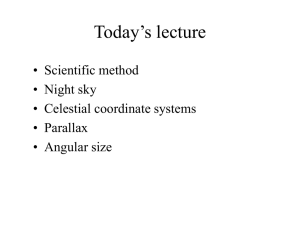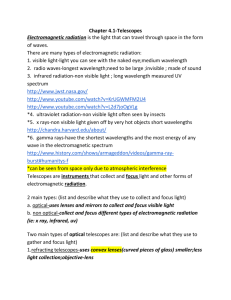P7 Observing the Universe- Specification Questions
advertisement
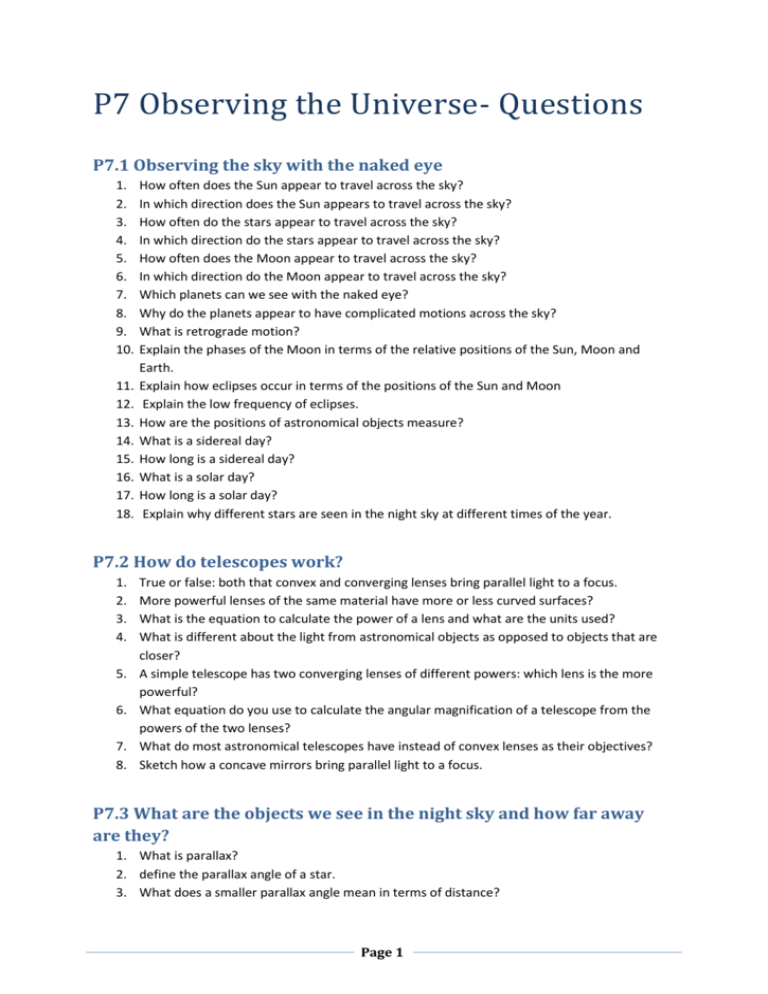
P7 Observing the Universe- Questions P7.1 Observing the sky with the naked eye 1. 2. 3. 4. 5. 6. 7. 8. 9. 10. 11. 12. 13. 14. 15. 16. 17. 18. How often does the Sun appear to travel across the sky? In which direction does the Sun appears to travel across the sky? How often do the stars appear to travel across the sky? In which direction do the stars appear to travel across the sky? How often does the Moon appear to travel across the sky? In which direction do the Moon appear to travel across the sky? Which planets can we see with the naked eye? Why do the planets appear to have complicated motions across the sky? What is retrograde motion? Explain the phases of the Moon in terms of the relative positions of the Sun, Moon and Earth. Explain how eclipses occur in terms of the positions of the Sun and Moon Explain the low frequency of eclipses. How are the positions of astronomical objects measure? What is a sidereal day? How long is a sidereal day? What is a solar day? How long is a solar day? Explain why different stars are seen in the night sky at different times of the year. P7.2 How do telescopes work? 1. 2. 3. 4. 5. 6. 7. 8. True or false: both that convex and converging lenses bring parallel light to a focus. More powerful lenses of the same material have more or less curved surfaces? What is the equation to calculate the power of a lens and what are the units used? What is different about the light from astronomical objects as opposed to objects that are closer? A simple telescope has two converging lenses of different powers: which lens is the more powerful? What equation do you use to calculate the angular magnification of a telescope from the powers of the two lenses? What do most astronomical telescopes have instead of convex lenses as their objectives? Sketch how a concave mirrors bring parallel light to a focus. P7.3 What are the objects we see in the night sky and how far away are they? 1. What is parallax? 2. define the parallax angle of a star. 3. What does a smaller parallax angle mean in terms of distance? Page 1 P7 Observing the Universe Questions 4. 5. 6. 7. 8. 9. 10. 11. 12. 13. 14. 15. 16. Define a parsec. True or false: a parsec is similar in magnitude to a light-year. How large are typical interstellar distances? What does the luminosity (intrinsic brightness) of a star depends on? Why does the observed intensity of light (observed brightness) of a star (as seen on Earth) depends on its luminosity (intrinsic brightness) and its distance from Earth? What is the period of Cepheid variable star’s pulse in brightness related to? Explain qualitatively how this relationship enables astronomers to estimate the distance to Cepheid variable stars. Name two things that telescopes have helped reveal. What was the main issue in the Curtis-Shapley debate? What observation was made that ‘solved’ the debate and who made it? How large are typical intergalactic distances? What has helped give accurate values of the Hubble constant? What is the equation (and units) for the Hubble constant? P7.4 What are stars? 1. What emits a continuous range of electromagnetic radiation? 2. How are luminosity and peak frequency of electromagnetic radiation affected by temperature? 3. Define ionisation. 4. What produces line spectra? 5. What are specific spectral lines within the spectrum of a star evidence of? 6. When the volume of a gas is reduced how is its pressure affected? 7. Why does the pressure or volume of a gas varies with temperature 8. What is absolute zero? 9. How do you convert to Kelvin (K) from degrees Celsius? 10. Explain the formation of a protostar in terms of the effects of gravity compressing a cloud of gas. 11. Why could they not explain the source of the Sun’s energy before the 20th century? 12. What effect does compressing a gas, e.g. in a protostar, have on its temperature; 13. What did the results of the Rutherford-Geiger-Marsden alpha particle scattering experiment show? 14. What does the nucleus of an atom contain (and what are their respective charges)? 15. What force holds protons held together in the nucleus (and which force is this greater than)? 16. What can hydrogen nuclei can fuse into? 17. What are the layers of a star (in order from the centre outwards) and what occurs in each layer? 18. What happens in a star once hydrogen fusion has ceased? 19. How are red giants and red supergiants ‘fuelled’? 20. What does the lack of mass in a red giant led to? 21. How may fusion in red supergiants continue to larger nuclei? 22. When does fusion in large stars ceases and what happens? Page 2 P7 Observing the Universe Questions P7.5 How do astronomers work together? 1. Where are the major optical and infrared astronomical observatories on Earth mostly situated? 2. Why are large telescopes are needed? 3. Why must the aperture of a telescope be very much larger than the wavelength of the radiation detected by the telescope to produce sharp images? 4. What are the main advantages and disadvantages of using telescopes outside the Earth’s atmosphere? 5. Why is there a need for international collaboration? 6. Give one example showing how international cooperation is essential for progress in expensive ‘big science’ projects such as astronomy. 7. Which non-astronomical factors are important considerations in planning, building, operating, and closing down an observatory? Page 3

